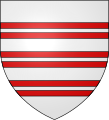Canting arms
This article needs additional citations for verification. (August 2011) |

Canting arms are heraldic bearings that represent the bearer's name in a visual pun or rebus. The term cant came into the English language from Anglo-Norman cant, meaning song or singing, from Latin cantāre, and English cognates include canticle, chant, accent, incantation and recant.[2]
French heralds used the term Armes Parlantes ("Talking Arms"), as they would sound out the name of the armiger.
Canting arms – some in the form of rebuses – are quite common in German civic heraldry. They have also been increasingly used in the 20th century among the British royal family.[citation needed] When the visual representation is not straightforward but as complex as a rebus, this is sometimes called a rebus coat of arms.[citation needed] An in-joke among Society for Creative Anachronism heralds is the pun, "Heralds don't pun; they cant."[3]
Examples of canting arms
Personal coat of arms
A famous example of canting arms are those of Queen Elizabeth the Queen Mother (Queen Consort of the United Kingdom 1936-52 and Queen Mother 1952-2002). Her arms (pictured below) contain in sinister (i.e. on the bearer's left, viewer's right) the bows and blue lions that make up the arms of the Bowes and Lyon families.
-
Princess Beatrice of York: Beatrice = bee thrice = three bees
-
Quintin Hogg, Baron Hailsham of St Marylebone: three hog's heads
-
De Barry family: three bars gemelles
-
Flag of Maryland, originally the arms of George Calvert, 1st Lord Baltimore, whose mother's maiden name was Crossland; the latter's arms shows a cross on land (the field).[4]
Municipal coat of arms
Municipal coats of arms which interpret the town's name in rebus form are also called canting. Here are a few examples.
-
Elmbridge, Surrey (1974): elm tree on bridge. (The toponym is related to bridges but not to elms; the prefix refers to Emel, a former name for the river Mole.[5])
-
Châteaurenard: Château = castle; Renard = fox
-
Eberbach (1976): Eber = boar; Bach = brook (wavy blue fess)
-
Freixo de Espada à Cinta (1926): Freixo = ash; de Espada = with sword; à Cinta = at the waist, in Portuguese
-
Falkenberg (1971): Falken = falcon; Berg = hill, in Swedish
-
Berlin (1954): Bär = bear
-
Torrevieja (1829): Torre = tower, vieja = old
-
Kryvyi Rih: Kryvyi = crooked, Rih = horn, in Ukrainian
Notes
- ^ http://www.heraldica.org/topics/canting.htm
- ^ Template:Cite article
- ^ Neznanich, Modar. "Heraldry for Those Who Cant" (PDF). Retrieved 2 July 2012. Cites 72 historical examples of canting arms, as well as SCA usage.
- ^ Englefield, Eric (1979). Flags. Ward Lock. p. 104.
{{cite book}}:|access-date=requires|url=(help) - ^ Room, Adrian (1988). Dictionary Of Place Names In The British Isles. Bloomsbury. p. 128.
- ^ Weeks, Andrew. "Obdam (The Netherlands)". Flags of the World. CRW Flags. Retrieved 16 September 2011.
- ^ Schneider, Klaus-Michael. "Municipality of Manacor". Flags of the World. CRW Flags. Retrieved 16 October 2013.
References
- "Meaning of Arms". Heraldica.org. 2001-06-20.







![Flag of Maryland, originally the arms of George Calvert, 1st Lord Baltimore, whose mother's maiden name was Crossland; the latter's arms shows a cross on land (the field).[4]](http://upload.wikimedia.org/wikipedia/commons/thumb/a/a0/Flag_of_Maryland.svg/120px-Flag_of_Maryland.svg.png)

![Elmbridge, Surrey (1974): elm tree on bridge. (The toponym is related to bridges but not to elms; the prefix refers to Emel, a former name for the river Mole.[5])](http://upload.wikimedia.org/wikipedia/commons/thumb/f/fd/Elmbridge_BC_Crest_of_Arms.png/120px-Elmbridge_BC_Crest_of_Arms.png)


![Hensbroek (1817[6]): The coat of arms of the village of Hensbroek in North Holland interprets the toponym as "hen-breeches" (the toponym is unrelated to either "hen" or "breeches", deriving from a personal name Hein and the Dutch cognate of "brook", i.e. "Henry's brook".)](http://upload.wikimedia.org/wikipedia/commons/thumb/6/6b/Hensbroek.svg/105px-Hensbroek.svg.png)




![Manacor: man = hand, a = at, cor = heart, in Catalan[7]](http://upload.wikimedia.org/wikipedia/commons/thumb/c/c4/EscutdeManacor.jpg/103px-EscutdeManacor.jpg)


